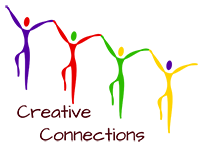Finnish Lesson Plan
Scheme of Work: Me as a European
Recommended Age Group: 7-8
Timescale: 6 lessons (1-2 hours each)
Country: Finland
School: Koskela koulu, Suomi
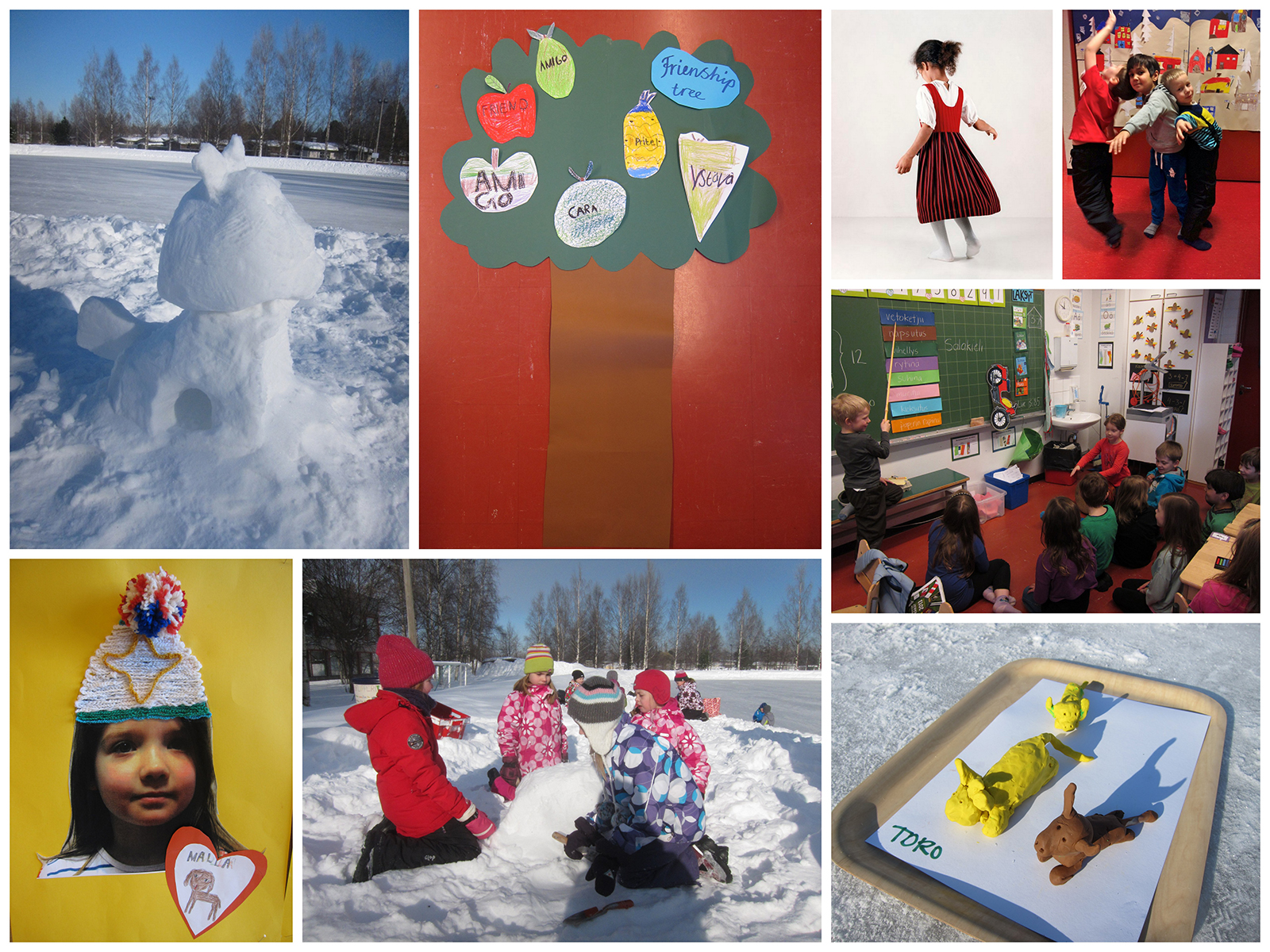
Conceptual Framework:
These lessons allow pupils to explore their own identity through European contemporary art. Often pupils are required to work on individual pieces of work in visual art lesson and here they are actively encouraged to work together in a collaborative way in groups. A range and different media (photography, musical instruments, snow sculpture) and other art forms (sound, movement, role play) are introduced as valid and viable ways for pupils to express their ideas and thoughts.
Lessons/ Assignments included to the Scheme work:
- Introduction,
- Friendship tree,
- My woolly hat,
- Finnish version of the artworks- photo assignments,
- Snow sculpture,
- Soundscapes.
Key Words
- Group work,
- Languages,
- Country emblems,
- Snow sculpture,
- Soundscapes,
- Role-play,
- Photography.
Learning Objectives
Pupils will:
- Practice group working skills,
- Get to know the partner countries and look for information,
- Be encouraged to analyse and comment on contemporary artworks,
- Produce their of versions and responses to chosen artworks.
Activities
Lesson 1 Introduction
Pupils get to know about the other countries in the project by looking for information about other Creative Connections countries, such as the flags and symbols of each country. They use iPads to research and make mind-maps to record their findings.
Resources and Preparation
- Computers or iPads with Internet connection,
- Paper and pens.
Activities
The pupils work in small groups. Each group looks for information of one of the partner countries from the Internet.
They then make mind maps by drawing images and writing words that they find to be important (for example they might draw the country’s flag, symbol, typical food, animals, musical instruments…etc.)
Lesson 2 The Friendship Tree
Pupils make a ‘friendship tree’ in which the fruits are the word “Friend” in different languages.
Resources
- Computers or iPads with Internet connection,
- Large and small pieces of coloured paper,
- Scissors,
- Drawing materials.
Activities
The idea is to explore the different languages. The pupils discuss together to choose a word that signifies an aspect of citizenship, such as ‘Friend’. They then search for their word in all languages.
Pupils create a plain tree shape by using large coloured paper. Each pupil creates a drawing in the shape of a fruit and adds this to the tree.
Lesson 3 My woolly hat
Pupils make self-portraits with woolly hats of their own design, with a secret message that carries an image of an important personal object, or a written wish for the future.
Resources and Preparation
- iPad/ Camera,
- Paper,
- Yarn/thread,
- Copy of the pupils photo,
- Crayons,
- Scissors,
- Glue,
- Crochet hook
Activities
The pupils take photographic portraits of each other with iPad/ digital cameras
Up-load these images to a computer and print them out.
Pupils cut the figure out of the portrait photo and glue it to a larger piece of paper.
Teach pupils how to crochet. http://www.youtube.com/watch?v=u_du_2GOEmc
Pupils choose colours for their hat and make a crochet chain with yarn.
Pupils design their own woolly hats with their crochet chains and glue it to the portrait.
Then the pupils make a bobble for the woolly hat with the colours from the Creative Connections partner countries’ flags.
Pupils think of something that is important for them, or a wish that they have and write or draw this on a pre-cut heart shape. The heart is then glued on the portrait picture.
Lesson 4 Own versions of the artworks - Photography
The aim of this lesson is to analyse artwork by responding to the composition and subject matter using digital photography.
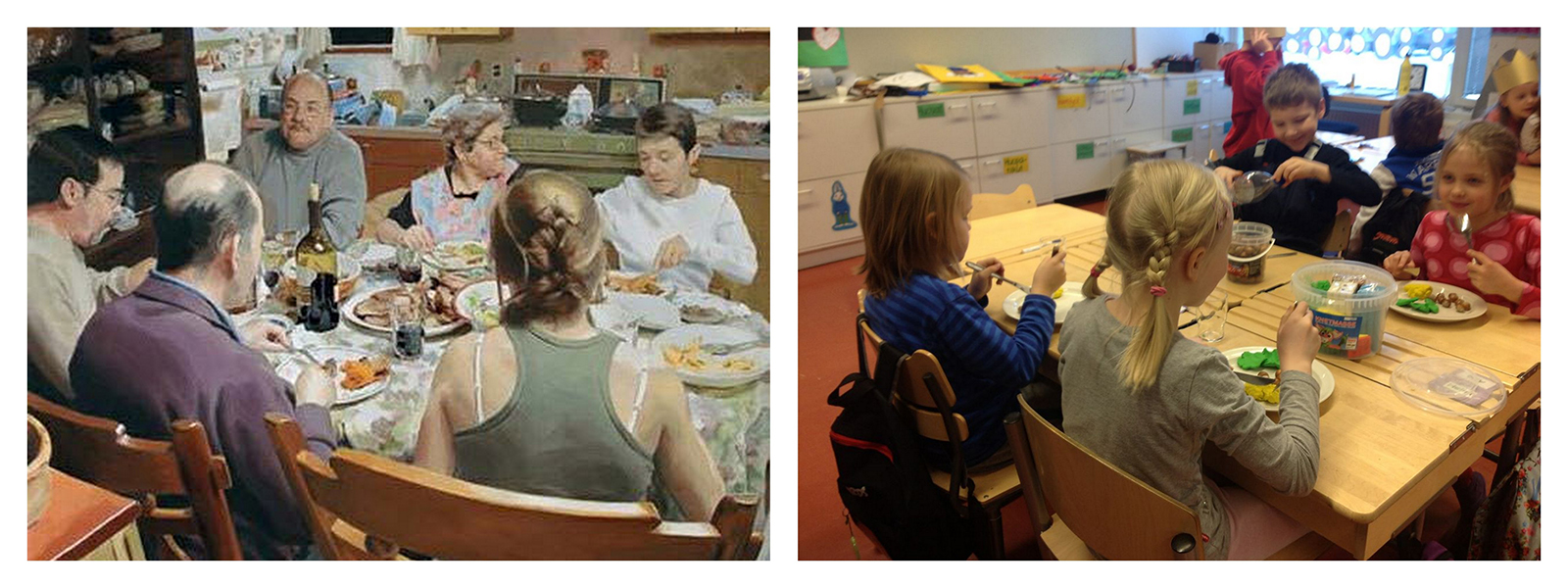
image text: The original artwork by Michael Brito (Gathering) and the pupils’ version - a Finnish family having a meal
Resources and Preparation
- Selection of artworks from the database,
- Cameras/iPads,
- Props (objects, clothes, plasticine, paper, scissors, glue, etc.)
- Presentation with projector or paper prints.
Recommended artwork from Creative Connections Database for use with this project:
- Michael de Brito: The Gathering
- The Singh Twins: From Zero to a Hero (the New Royal Family)
- Raakel Kuukka: Rebekka and the national dress
- Petri Hytönen: Finland - Sweden
Activities
Analyse the selected artworks with the pupils;
- What is in the picture?
- Who do you think this person might be?
- Why have they been portrayed in this way?
- What is the time/place/etc?
- What would be equivalent sport/person/place/situation like in our country?
- What would it be in the other countries? (link here to the questioning resource)
Pupils divide into groups and choose the roles: Who is photographer, who are the models for the photograph.
The pupils, in their groups, create an interpretation of the selected work by setting up a life sized scene. For example, they choose the place and furniture/objects needed, and then arrange them. They might also wish to make some resources, clothing or objects from material, paper or modelling material, such as plasticine or clay, to be included. They decide upon the postions that the models will take, and what they will wear. Once they are happy with their composition, pupils take photographs of the scene, and then upload these to the computer. Ask them to view the photographs and decide which is the one that they are happiest with in terms of clarity and balance etc.
Bring the class together to share their images on the interactive whiteboard and discuss these in comparison with the original artworks.
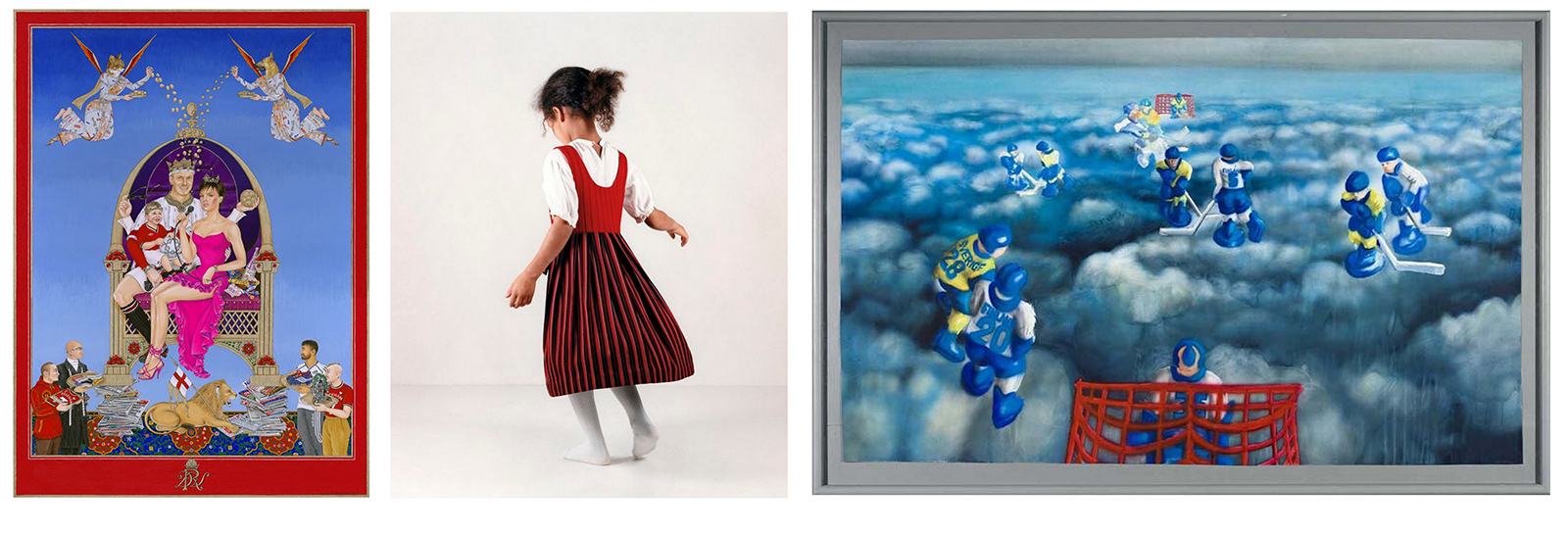
Lesson 5 Snow sculpture
Pupils will learn snow sculpture techniques and sculpt a chosen emblem/national animal of each project country.
Inspiration for this activity is from the snow sculpture example in Artwork database: Fathers’ Signs by Timo Jokela, Finland.
Resources and Preparation
- Paper, pencils and Plasticine for sketches,
- Plastic barrels/big plastic sacks/boxes to create starting shape for sculptures,
- Snow sculpture tools such as chisels, knives and picks, sticks, branches, stones,
- Camera/iPad

Activities
Pupils should continue to work in their groups. Invite the pupils to use the research they have done on finding out about the different countries and to choose an emblem or animal that represents a country. Ask the pupils to start by making miniature models of their chosen emblem or animal in plasticine as a maquette.
Pupils make snow blocks for the sculptures by stamping snow into boxes/barrels/plastic sack. Leave the snow block to harden in the boxes overnight (temperature needs to be below zero).
When the snow is very hard pupils can use the tools to create large sized 3D sculptures, using the maquettes as sketches to work from.
Pupils might wish to add details and finish the animals with stones and branches if needed.
Ask the pupils to document their work by taking photographs. They will also need to photograph the end result. These can be used to review the work with the pupils back in the warm classroom!
Lesson 6 Soundscapes
Soundscape for an artwork - Making an interpretation into another art form.
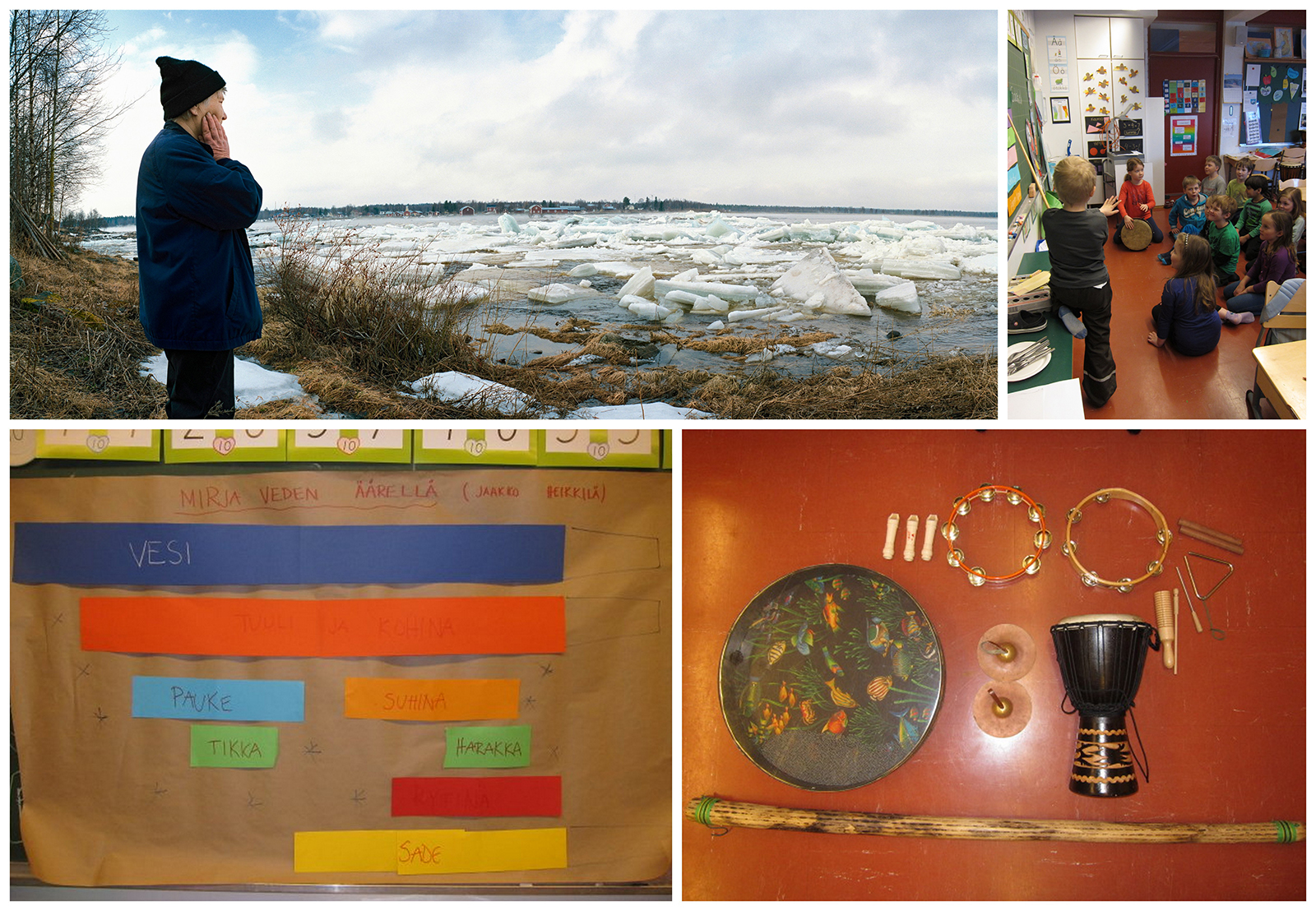
The instruments used to produce the soundscape
The Soundscape made for the artwork Jaakko Heikkilä: Mirja by the River
Resources and Preparation
- Different music instruments,
- Rhythm instruments and objects,
- Big sheet of paper for drawing the “partitura”.
Activities
Select an artwork from the Creative Connections Artwork Database, The Connected Gallery, for pupils to analyse in their small groups, or as a whole class together. A good example for this activity is Jaakko Heikkilä’s Mirja by the River.
Engage the pupils by asking open-ended questions related to the image. For example:
- What is happening in the photograph?
- What season do you think it is in the picture?
- What kind of ambience/ atmosphere is created in this picture?
Possible responses might include that pupils recognise that the picture is set in spring time, beside a river bank when the ice is starting to melt, break and move out from the river. The atmosphere is calm and tranquil.
Ask the pupils to imagine what kind of sounds you might hear by looking carefully at the image. Ask them to name the sounds and collect these words together on the whiteboard.
The pupils can be challenged to find musical instruments that would best relate to each word, to produce sounds. The sounds can also be made without using musical instruments by using one's own body as a percussion instrument (clapping, whistling, hissing, etc) , or by creating sounds using found objects (cups, pens, desks).
Pupils can then work in groups to compose a score, a “partitura” of the sounds, and play this with the instruments.
Pupils should practice their composition and record the soundscape. Bring the whole class together to listen to the soundscapes whilst at the same time viewing the original picture, and encourage pupils to reflect upon the result.
Another example, a soundscape to Eduard Ovcaceks painting ‘Signs.’
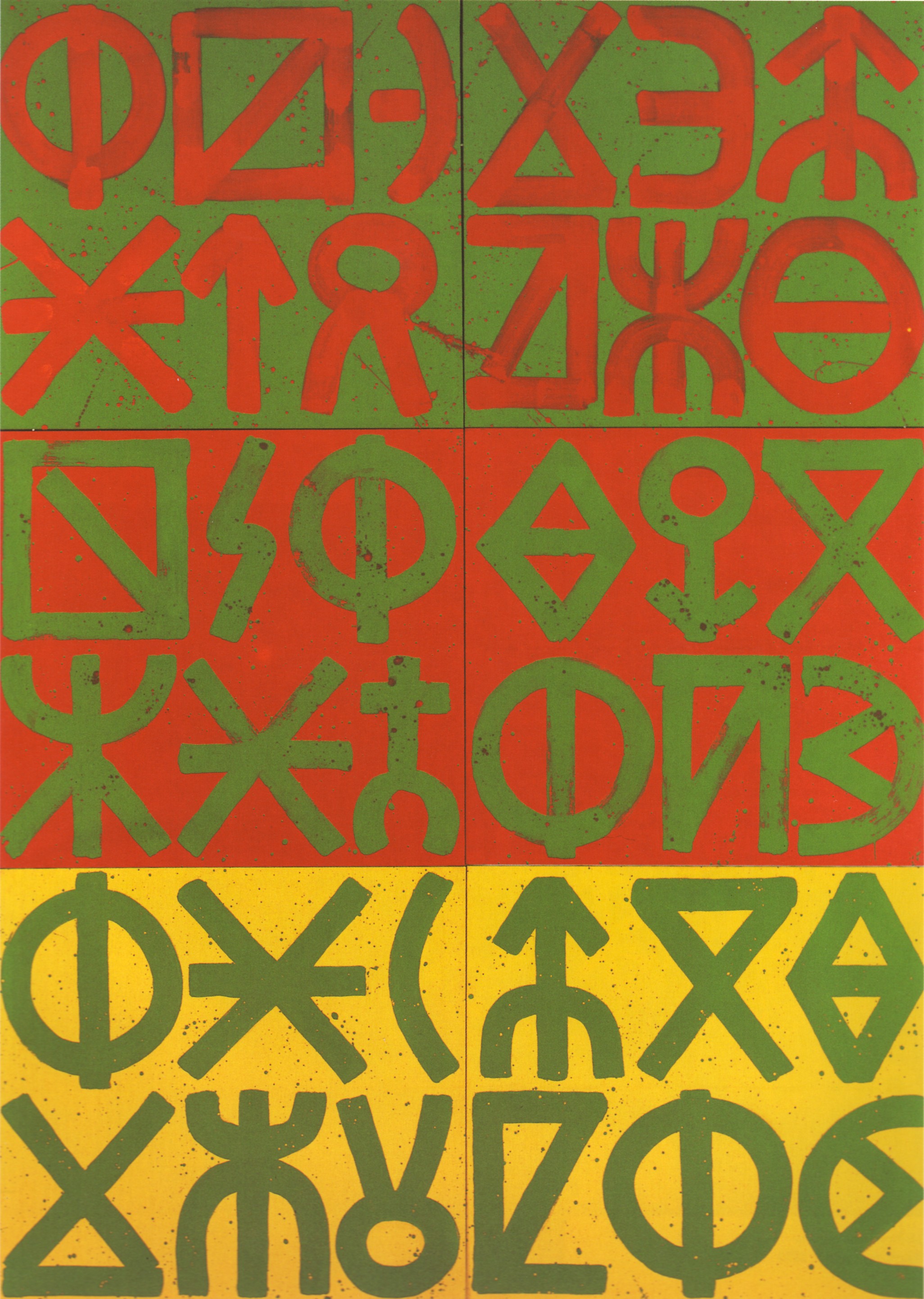
Eduard Ovcacek: Signs
Learning Outcomes/Assessment
- The pupils group working skills are developed and social cohesion increased.
- Pupils gain a natural and unprejudiced attitude towards contemporary arts.
- Pupils learn new information and gain knowledge about partner countries and other pupils’ lives.
- Pupils appreciate their own works and are proud of their accomplishments.
